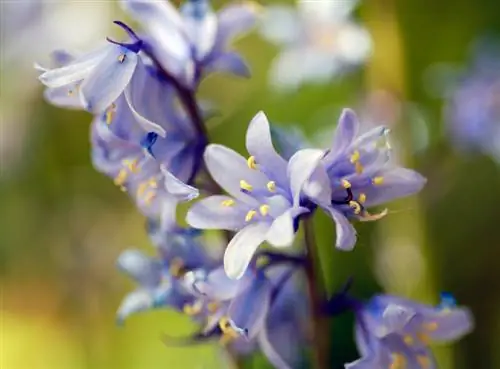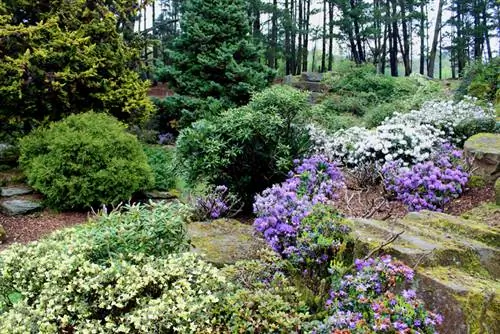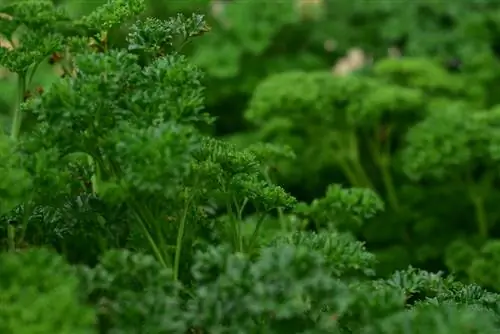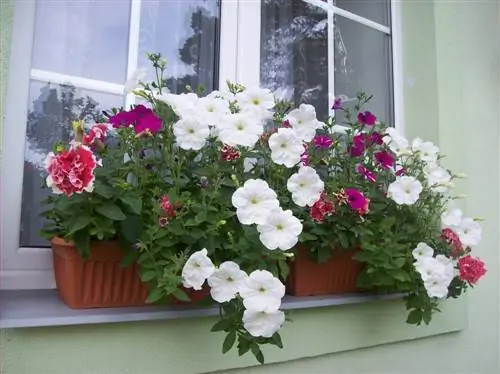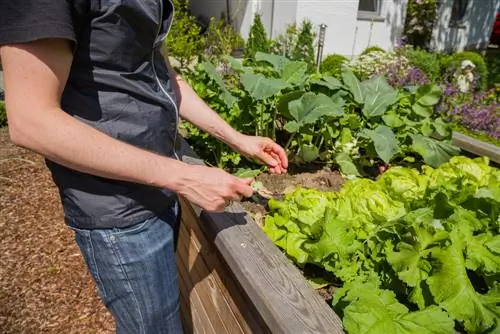- Author admin [email protected].
- Public 2023-12-25 17:45.
- Last modified 2025-01-23 11:22.
The hare bell rings in spring with delicate bell-shaped flowers in blue, white or pink. Are you wondering how the striking onion flower unfolds its floral magic in shady locations? Then discover answers here as if Mother Nature had formulated them.
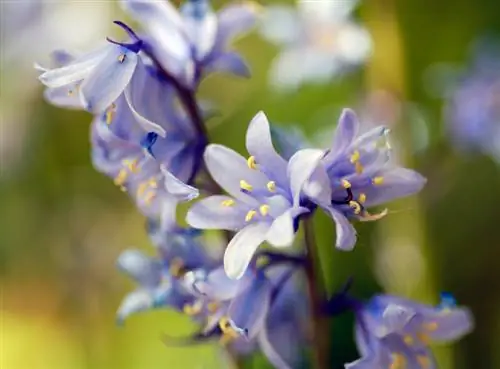
How do you plant and care for harebells?
Hare bells are bulb flowers that delight in spring with blue, white or pink bell flowers. They prefer partially shaded to shady locations and permeable, humus-rich soil. Planting takes place in September at a depth of 6-10 cm, depending on the species.
Planting rabbit bells correctly
The window of opportunity to plant harebell flower bulbs opens in September. Choose a partially shaded to shady and cool location with well-drained garden soil. Make small pits there at a distance of 10-12 cm. For an Atlantic harebell, the planting depth is 6-8 cm, while the larger bulbs of the Spanish harebell are planted 8-10 cm deep. Loosen soil that is too clayey with a handful of sand. If your garden is infested with voles, we recommend planting each group of bulbs under the protection of a fine-mesh wire basket.
Care tips
If the location meets the most important criteria and the planting is carried out professionally, the harebell requires little gardening attention. How to properly care for the herald of spring:
- Watering when dry, preferably alternating with tap and rainwater
- Fertilize organically every 2 weeks during the growth and flowering period
- Clean out wilted flowers for rebloom
- Cut off the heads at the end of the flowering period
- Only cut off the leaves close to the ground when they have completely yellowed
In harsh locations, the harebell is grateful for light winter protection. Cover the planting site with a layer of leaves and coniferous twigs so that they can be removed in good time in February/March.
Which location is suitable?
The harebell enjoys popularity throughout Europe, not least thanks to its ability to beautify shady niches in the garden with floral colors. The bell-shaped abundance of flowers develops particularly beautifully in a partially shaded to shady location. In combination with humus-rich, fresh, moist and well-drained soil, the flower develops enchanting carpets of flowers over the years.
The correct planting distance
The hare bells are particularly decorative in small tuffs. Therefore, arrange the flower bulbs in small groups 10-12 cm apart. In this way, you give each individual specimen enough space to develop unhindered without creating unwanted gaps in their appearance.
What soil does the plant need?
As a classic onion bloomer, bluebell squill primarily requires well-drained soil without the risk of waterlogging. If the soil is humus and has a fresh, moist structure at the same time, the spring flower will achieve its optimum right from the start.
What is the best time to plant?
The charming harebell moves into your garden as a bulb flower. For these ornamental plants, the planting time extends from the beginning of September to November. After the first frost, the window for planting closes, regardless of what the calendar says.
When is flowering time?
The harebell presents us with two species that bloom at different times. The Atlantic harebell - also known as forest hyacinth - presents us with its nodding flower bells from April to May. The Spanish harebell - also known as bluebell squill - delights us with its floral display from May to June.
Cut rabbit bells correctly
You always attract new bells when you clean out withered flowers. If the flowering period inevitably comes to an end, cut off all flower heads. In this way, the harebell does not invest all of its energy in the strenuous growth of seed heads. As a result, wait until all of the foliage is absorbed and yellows. Only then do you cut off the withered leaves close to the ground.
Water rabbit bells
In a cool, partially shaded location, the soil does not dry out as quickly; however, we recommend keeping an eye on soil moisture levels during flowering. If the soil surface feels dry, water moderately. Ideally, you should alternate between tap water and collected rainwater so that the lime content in the soil does not get out of hand. Outside the growth and flowering period, natural rainfall covers water requirements.
Fertilize rabbit bells properly
The blue squill does not have any lofty demands when it comes to nutrient supply. If you supply the flower with sifted compost and horn shavings every 14 days when it begins to sprout, your needs will be met. At the end of the flowering period, stop adding fertilizer so that the bulb goes into its summer rest mode.
Wintering
If the location is under deciduous trees, leave the fallen leaves lying in autumn as natural protection against frost and constant wetness. In rough locations, you can also spread a few pine fronds over the hare bells. Otherwise, the onion flower is well hardy and continues to grow for many years. In the pot or balcony box, after cutting back close to the ground, put the spring bloomers in a frost-free, not too dark winter quarters.
Propagate rabbit bells
As a bulb flower, the harebell produces vital offspring every year on its own. This is how the fascinating flower carpets are created, which attract hordes of pilgrims every year in the famous garden of Wisley in England. You can let nature take its course or use this process for targeted propagation. This is how it works:
- Dig up the onion in September/October
- Cut off the clearly visible daughter bulbs with a sharp, disinfected knife
- Immediately plant 6-8 cm or 8-10 cm deep in the soil at the new location and water
Sowing, on the other hand, is more complicated and time-consuming. Since these are cold germinators, stratification is required to break the germination inhibition. In addition, several years pass until a harebell propagated from a seedling blooms for the first time.
Is harebell poisonous?
The cultivation of harebells is only suitable to a limited extent for the family garden. Due to the content of toxic saponins and other ingredients, the spring flower is classified as questionable. Skin contact with the plant sap can lead to allergic reactions. Eating seeds and onions has dire consequences, as there is a risk of symptoms of poisoning, such as vomiting, diarrhea and palpitations.read more
Trivia
Where a sea of harebell flowers spreads out in the spring forest, the hiker's eye can enjoy it. However, picking or removing forest hyacinths from wild populations is strictly prohibited. Hyacinthoides are protected in Germany because they are threatened with extinction.
Beautiful varieties
- Blue Bell: Blue-violet bells adorn the nodding green stems above lanceolate foliage; Growth height 20-30 cm
- White Triumphator: White flowering variety that harmonizes wonderfully with blue hare bells; Growth height 20-30 cm
- Excelsior: Distinctive garden harebell with blue to dark blue flowers in April and May; Growth height 30-40 cm
- Blue Queen: Impresses with lavender-blue flowers until June; Growth height 25-35 cm
- Alba: Atlantic harebell with white flowers and robust constitution: height 25-40 cm
- Rose Queen: Royal variety with delicate pink flower bells, suitable for cut flowers; Growth height 30-45 cm

